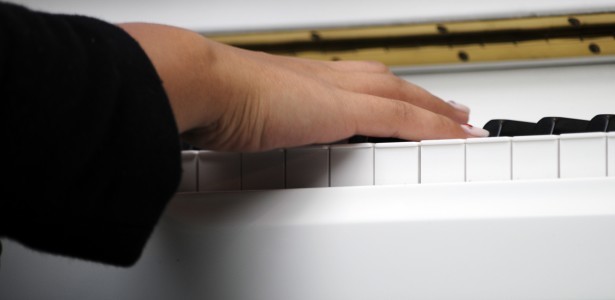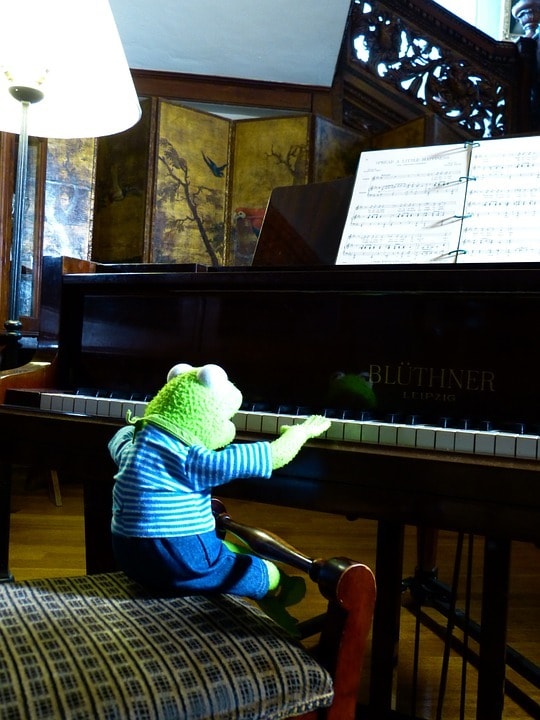
Improvising is one of the ways to truly enjoy music because it involves a lot of fun, creativity, and playfulness. Although most piano improvisation tends to be in the jazz, rock and blues genres, that doesn’t mean you cannot improvise in whatever musical style you choose.
If you’re just starting out on piano improvisation, there’s a lot you need to learn, but everything new just adds to the fun. An electronic keyboard offers the advantage of built-in rhythms and auto-chord features that will give you something of a virtual backup band, allowing you to focus on the melody.
That would be a good place to start for a beginner, but again, that doesn’t mean you can’t improvise on an acoustic piano. Christopher Sutton suggests these 5 steps to piano improvisation that a beginner will definitely find helpful:
1. Start at the beginning – one note
One of the reasons many beginner improvisers become frustrated is that they attempt too much too soon. Playing with both hands at the same time or diving into chords and harmony will definitely be too much to start with.
Make life a bit easier on yourself. First aim to master improvising single-line melodies, meaning one note at a time. That naturally also implies one hand at a time!
Begin with free improvisation, just getting used to choosing notes by instinct. Then find a good backing track or song to improvise over so the music isn’t quite so bare. Remember: one note at a time! Via Easy Ear Training
2. Get started on triads

Once you have your single notes down, you can now attempt some harmonies on your left hand. Triads are the simplest chords and, therefore, the best place to start playing harmonies.
Learn the major and minor triads and practice playing them as block chords in your left hand (all notes at once) and arpeggios in both hands (one note at a time, up and down). This lets you start using chord tones for improvisation.
Use the most common chord progressions as the basis for your improvisations and you’ll suddenly be improvising “real sounding” musical arrangements from nothing.
Don’t try to tackle every key at once. Learn the most important chords in just one or two keys and improvise in those keys to begin with. Via Easy Ear Training
3. Get some help

Books containing lead sheets for your favorite songs are a great resource to help you practice your piano improvisation. Familiar songs are best as it will be easier to improvise.
Once you’re getting the hang of improvising over common chord progressions you can apply your new two-hand skills to some classic tunes.
Get a “fake book” which contains the lead sheets for songs in a style you like, whether that’s jazz, pop or rock. These show you just the melody (for your right hand) and chord symbols (for triad chords in your left). Play through the melody then improvise a solo in its place.
As you explore the fake book you can gradually expand your improvisation skills to more keys, progressions, types of chord, and musical styles in a structured and rewarding way. Via Easy Ear Training
4. Free yourself

Your improvisation skills should develop to a point where you can create music off the top of your head. After playing from fake books for a while, you should naturally start to break free from the sheet music.
After playing from fake books for a while you’ll instinctively start wanting to break free from that dependence on sheet music – after all, improvisation is about creating music from scratch, right?
So take all your expanded skills (chord types, progressions, scales, keys, styles) and return to the approach of simply sitting down at the keyboard and imagining something to play. You should now have a lot more ideas in your toolkit! Via Easy Ear Training
5. Try a little bit of everything
As you practice, you might notice that you’re starting to do the same things over and over again. If your improvisations are becoming repetitive, it’s time to challenge yourself and do something new – maybe in a style you’ve never tried?
Again, fake books and improv games can be helpful here, to prompt you in specific ways. You can also gradually expose yourself to more and more musical situations, for example by volunteering to provide background or filler music for a performance or event.
Keep pushing your improvisational boundaries and aim to be the kind of pianist who can play anything they (or anyone else) can imagine! Via Easy Ear Training
Featured Image: Image Credit
On April 18, 1930, BBC reported that there was no news to be reported, so instead they played piano music. ?
— World Class Facts (@WorldClassFacts) March 21, 2016
Anyone feel like playing some piano? https://t.co/aad5c1qkQZ pic.twitter.com/BK2aVzrkdQ
— Joseph Gordon-Levitt (@hitRECordJoe) March 19, 2016
Related Articles:
Techniques and Tips for Piano Improvisation
Whether you are a learner or a beginner piano player or even if you have reached a certain level of learning the basics of piano, you may encounter some situations when you have piano in front of you and you don’t know what to play? Such situations can turn in to embarrassing scenes. How to avoid them? The answer lies in improvisation techniques that enable you to polish your musical techniques and ability to play even the notes that you are not really familiar with. Improvisation cultivates natural ability of playing and guide you through various ideas of playing over keyboard like a pro. Via Best Digital Piano Guides
Tips and Techniques to Piano Improvisation
There comes a point in life when improvisation is called for. Piano playing is not left out of such scenarios. There may come a time when you need to improvise during your piano playing regardless of whether you are a teacher or a learner. At such moments, some of the techniques and tips given below can come in handy. Examples of such scenarios include being presented with notes that you are not familiar with or being asked to play chords or tunes that you have little knowledge of. Via Digital Piano Review HQ
4 More Improvisational Tips for Piano Players at Any Level
Improvisation is the technique of making up music on the spot. Most music students think piano improvisation is only for advanced students and professional players, but everyone has the ability to create music spontaneously. I’ve seen many beginner piano students come alive with a little structure and guidance using some of the simple ideas below. I have also observed students who blossom more from improvisational learning than from music reading and lesson books. In any case, I think it is important to have a balance between musical exploration and fundamental keyboard skills to become a well-rounded piano player. Via Take Lessons

